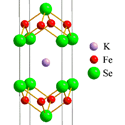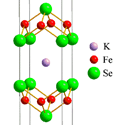NMR uncovers missing magnetic fluctuations
The source of high-temperature superconductivity in several families of iron-based compounds remains a controversial issue despite the existence of some tantalizing clues from a large number of experiments. Until recently, a consensus had started to form around the notion that Fermi surface nesting between hole bands (at the center of the Brillouin zone) and electronlike bands (at the zone edges), which in turn induced antiferromagnetic fluctuations, had to play an important role in the emergence of superconductivity. The discovery last year of a new iron-based superconductor, upended this consensus, however: photoemission measurements revealed that, in this compound, intercalation of into leaves no hole bands at the zone center—meaning these bands can’t play a role in superconductivity.
New measurements on this compound reported in Physical Review B are casting further doubt on the role of antiferromagnetic fluctuations—at least in a general theory for superconductivity in iron-based superconductors. Dave Torchetti and colleagues from McMaster University, Canada, and Brookhaven National Laboratory, US, have conducted a detailed NMR study on the selenium- nucleus in a single crystalline sample of this material across a broad temperature range. In contrast to the case of , there is no enhancement of antiferromagnetic spin fluctuations close to the superconducting transition temperature ( ), nor the co-existence of magnetic order with superconductivity. Torchetti et al. report some measurements that are consistent with s-type pairing, but the nuclear spin-lattice relaxation rate below doesn’t fit neatly into the picture of a conventional s-wave superconductor. – Sarma Kancharla





